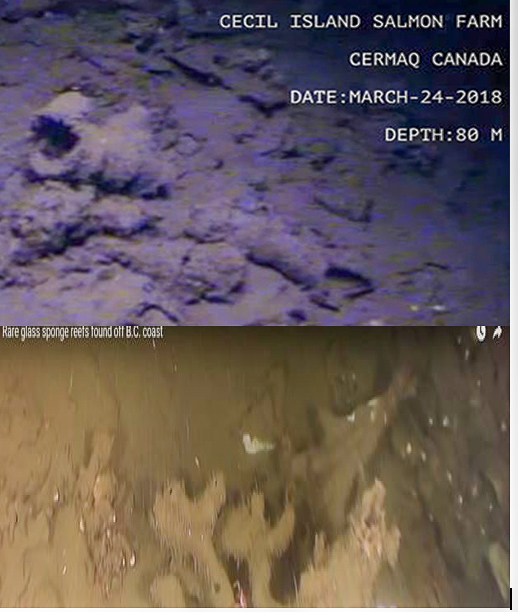“Shocking” glass sponge reef video not that shocking, says expert
Glass sponge reef video being peddled by anti-fish farm lobby is a natural occurrence says expert
(PICTURE: The top is a screen grab from a video of dead glass sponge reefs purportedly close to a salmon farm in the Broughton Archipelago. The bottom pix from a video by the CBC, shows dead glass sponge reefs in Hecate Strait, where there are no fish farms)
By Fabian Dawson
SeaWestNews
The so called “shocking video” of glass sponge reefs covered in sediment off the B.C. coast that is being peddled by the anti-fish farm lobby on social media, is not so shocking after all, says a seabed expert.
“It’s just trickery aimed to hoodwink the public,” said Greg Gibson, an environmental assessment biologist.
Gibson said the surprise and shock expressed by the people who took the video is laughable as what they are showing is what happens naturally in the ocean and has nothing to do with fish farm operations.
The “shocking” video taken by anti-fish farm cameramen, Tavish Campbell, was apparently shot close to a salmon farm in the Broughton Archipelago. It shows glass sponge reefs at different depths, some alive and others dead on the seabed.
“First of all glass sponges on the BC coast are not that rare,” said Gibson, who specializes in benthic monitoring for Marine Harvest Canada. “We see them quite often, both alive and dead, when reviewing video of the seabed”.
Gibson, a member of the College of Applied Biology and the Association of Professional Biologists, has been involved in aquaculture since 1993 and his duties include regulatory compliance and site assessments.
Glass sponges are remarkable filter-feeding marine animals with skeletons made of silica, which is the same material used to make glass.
Several large glass sponge reefs have been found in Hecate Strait and Queen Charlotte Sound, and a number of smaller reef complexes have been found in the Strait of Georgia. Most of the sponge reefs in the Strait of Georgia are found at depths of 90 to 300 metres, except for a few rare reefs in Howe Sound that are as shallow as 30 metres.
While individual glass sponges appear around the globe, glass sponge reefs were thought to have disappeared 40 million years ago — until the discovery of a massive reef in Hecate Strait in 1987.
Gibson said if you look at a video produced by CBC ( see video below) on glass sponge reefs in Hecate Strait, it is similar to that of the one produced by Campbell.
“Glass sponges are living organisms and like all living organisms they can die…when they die they do not process the natural marine snow and dead plankton that falls on them and they become smothered on the seabed…if the glass sponges are alive, they have the capacity to process this sedimentation,” said Gibson.
“This is the same everywhere in BC and the world and not related to fish farm activity.”
“It is hard to know where the (Tavish Campbell) video was shot…but it is not shocking at all,” said Gibson.
This is not the first time that video shot for the anti-fish farm lobby by Campbell has come in for scrutiny.
He produced an earlier video showing bright-red plumes emerging out of a pipe purportedly taken at a fish processing plant on Vancouver Island.
The processing plant had on several occasions tried to replicate what was shown on the video but failed. Several videographers who examined the so-called “blood water video” were skeptical of the claims that the film was not manipulated to show the red plumes.
Campbell told Seawestnews that the video was not manipulated.
Damaged Northern Region Glass Sponge
Related Links:
Anti-fish farmers leave taxpayers with hefty bill
Around the web:
Glass Sponge Reefs Rediscovered – CBC News

